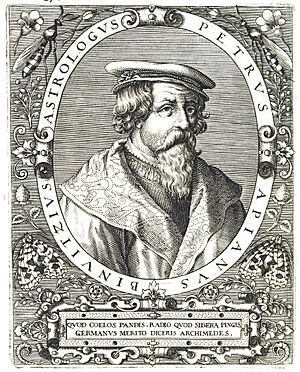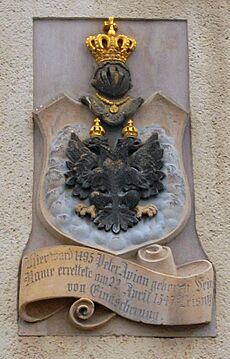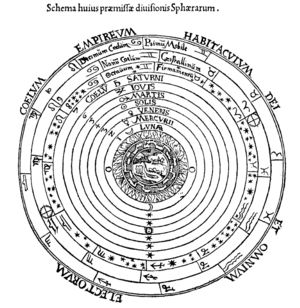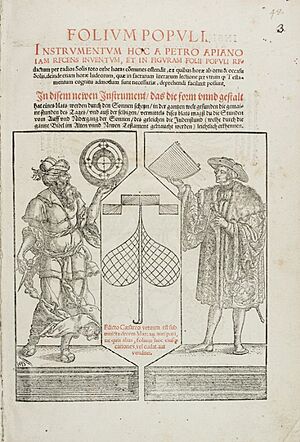Petrus Apianus facts for kids

Petrus Apianus (born April 16, 1495 – died April 21, 1552) was a smart German thinker. He was also known as Peter Apian. He made important discoveries in mathematics, astronomy, and cartography (map-making).
Apianus was famous for his work on "cosmography". This field studied the Earth and its place in the universe. His most well-known books were Astronomicum Caesareum (1540) and Cosmographicus liber (1524). These books were very popular and were printed many times until 1609. A crater on the Moon, Apianus, and an asteroid, 19139 Apian, are named after him.
Contents
Early Life and Education
Petrus Apianus was born as Peter Bienewitz in Leisnig, Saxony. His father, Martin, was a shoemaker. His family was quite well-off.
He went to a Latin school in Rochlitz. From 1516 to 1519, he studied at the University of Leipzig. During this time, he changed his name to Apianus. This was a common practice then. "Apianus" comes from the Latin word apis, which means "bee". His German last name, "Bienewitz", also relates to "Biene", the German word for bee.
Studies and First Books
In 1519, Apianus moved to Vienna. He continued his studies at the University of Vienna. This university was famous for geography and mathematics. His teacher there was Georg Tannstetter.
In 1521, a serious illness called the bubonic plague spread in Vienna. Apianus finished his studies and earned a Bachelor of Arts degree. He then moved to Regensburg and later to Landshut.
Cosmographicus liber
In Landshut, Apianus wrote his book Cosmographicus liber (1524). This book was highly respected. It taught about astronomy and navigation (how to guide a ship or plane). The book was reprinted over 40 times in four languages. It stayed popular until the late 1500s. Later versions were updated by another scholar, Gemma Frisius.
Professor and Printer
In 1527, Peter Apianus was invited to work at the University of Ingolstadt. He became a professor of mathematics and also started a printing shop. His print shop began small. It became known for printing high-quality books about geography and maps.
He likely used special printing methods with woodblocks. His printer's logo had a motto that meant "Hard work overcomes strength."
Royal Recognition
Apianus became a favorite of Holy Roman Emperor Charles V. The Emperor praised Apianus's Cosmographicus liber in 1530. Charles V then gave Apianus special rights to print books in 1532 and 1534.
In 1535, the Emperor gave Apianus the right to have his own coat of arms. This was a special honor.
Astronomicum Caesareum
In 1540, Apianus printed his most famous book, Astronomicum Caesareum. He dedicated it to Emperor Charles V. The Emperor was very impressed. He promised Apianus a large sum of money. He also made Apianus his court mathematician. Apianus was even made a "Free Imperial Knight" in 1544. All these honors made Apianus even more famous as a scientist.
Astronomicum Caesareum is known for its beautiful design. It was printed and bound very carefully. It included special paper tools called Volvelles. These tools helped users calculate dates and the positions of stars. Apianus said it took a month to create some of the printing plates for the book.
The book also included star names from an Arab astronomer named Azophi. Apianus also published a unique map in 1533. It showed how the Bedouin people saw constellations. For example, on this map, Ursa Minor (the Little Dipper) was shown as an old woman and three maidens.

Even though other universities wanted him, Apianus stayed in Ingolstadt until he died. The university was proud to have such an important scientist.
Scientific Discoveries
Apianus made many contributions to science.
- Mathematics: In 1527, he published a version of Pascal's triangle. In 1534, he created a table of sines, which are important in geometry.
- Astronomy: In 1531, he watched Halley's Comet. He noticed that a comet's tail always points away from the sun. Another scientist, Girolamo Fracastoro, also saw this. But Apianus was the first to publish this observation with pictures.
- Instruments: He designed sundials. He also published guides for using astronomical instruments. He made "Apian wheels" (volvelles). These were measuring tools for calculating time and distance for astronomy and astrology.
Family Life
In 1526, Apianus married Katharina Mosner. She was the daughter of a councilman from Landshut. They had fourteen children together: five girls and nine sons. One of their sons was Philipp Apian (1531–1589). Philipp continued his own research and also made sure his father's work was remembered.
Key Works
- Ein newe und wolgegründete underweisung aller Kauffmanns Rechnung in dreyen Büchern (1527). This was a handbook about math for merchants. It even appears in a famous painting called The Ambassadors.
- Cosmographiae introductio (1529). This book introduced ideas about cosmography.
- Ein kurtzer bericht der Observation unnd urtels des jüngst erschinnen Cometen (1532). This book was about his observations of a comet.
- Quadrans Apiani astronomicus (1532). This book explained how to use quadrants, which are tools for measuring angles.
- Horoscopion Apiani (1533). This book was about sundials.
- Instrument Buch (1533). This was a scientific book in German about astronomical instruments.
- Instrumentum primi mobilis (1534). This book was about trigonometry and included sine tables.
See also
 In Spanish: Pedro Apiano para niños
In Spanish: Pedro Apiano para niños






